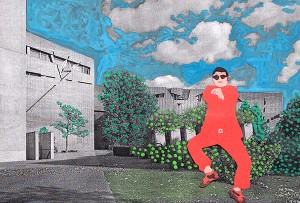Last summer, the Korean musician PSY sang out in protest against consumerism in Gangnam, a posh district in Seoul. His video shows him dancing, as if on a horse, in front of wealthy-looking men and scantily-clad women. For reasons only posterity may help us to understand, Gangnam Style became Youtube’s most frequently watched video clip.
A series of parodies were produced by groups as far distant from Gangnam – geographically and ideologically – as NASA and Greenpeace.
Gangnam-style protest reached the art world with particular fervour. Chinese activist Ai Weiwei released a Gangnam Style video in protest of censorship in his country.
Reacting to this video, Jewish-Indian artist Anish Kapoor – whose works are on display starting 18 May 2013 at the Martin-Gropius-Bau, Berlin – animated art museums in England and the USA to shoot a video in support of Ai Weiwei.
Shortly thereafter, the Philadelphia Art Museum posted a video with its staff members dancing to the Gangnam tune, though their object of contention is not immediately apparent:
As far as museums go, ours has a particularly large number of causes for protest. And being supporters of civil intervention, especially in modern media form, there is much to be said for producing a Jewish Museum Gangnam-style clip, or one in the style of Harlem Shake, which surpassed Gangnam in popularity in February 2013.
 Yet PSY’s use of performative contradiction – he resorts to the very images of consumerism he protests against – might backfire quite awkwardly in a screenplay on religious and social tolerance. We could find ourselves in somewhat of a muddle if the irony of a film showing, say, museum staff dancing horse-style up to a group of drunken men, drinking their beverages and wooing their women would prove to be elusive… Or not? What plot would you suggest for a Jewish Museum Gangnam-style video clip?
Yet PSY’s use of performative contradiction – he resorts to the very images of consumerism he protests against – might backfire quite awkwardly in a screenplay on religious and social tolerance. We could find ourselves in somewhat of a muddle if the irony of a film showing, say, museum staff dancing horse-style up to a group of drunken men, drinking their beverages and wooing their women would prove to be elusive… Or not? What plot would you suggest for a Jewish Museum Gangnam-style video clip?
Naomi Lubrich, Media